This cathedral, of the Roman Catholic Archdiocese of Salzburg, is dedicated to Saint Rupert and Saint Vergilius. It was founded by St. Rupert on the remnants of a Roman town. The first cathedral was built under Saint Vergilius of Salzburg, who might have used foundations by St. Rupert.
The present seventeenth-century Baroque cathedral was built in the seventeenth century under Prince-Bishop Wolf Dietrich Raitenau (also responsible for the building of the nearby Alten Residenz, which is today connected to the cathedral), a patron and supporter of modern Italian Baroque architecture, having seen it from its origins in Italy and particularly Rome.
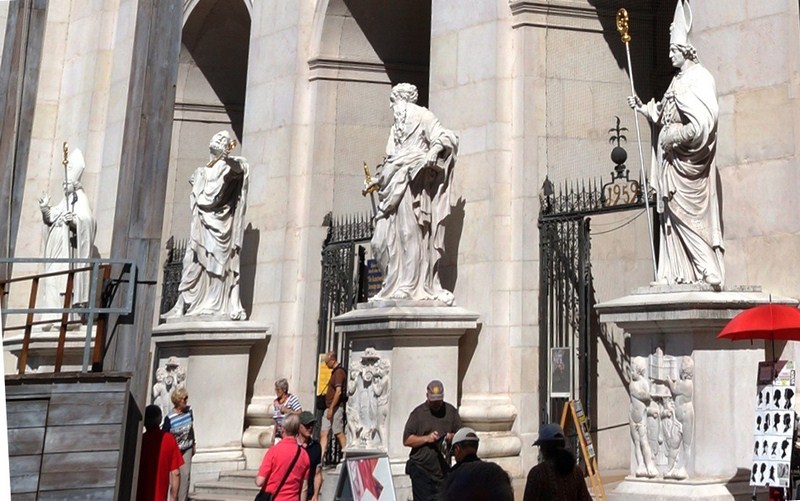
Statues of diocesean and cathedral patrons. The coats-of-arms of Prince Archbishop Guidobald von Thun and Prince Archbishop Johann Ernst von Thun are at the bases.
Here’s a historical timeline of the cathedral’s construction:
- In 774, the first Dom was recorded.
- From 767 to 774, the so-called 66 m. long and 33 m. wide Virgil Dom was built
- Archbishop Arno (785 – 821) was the first to arrange renovations of the Dom, which was in place for less than 70 years.
- In 842, the building burned down after being struck by lightning.
- Three years later, the re-erection of the building started.
- Between 1000 and 1080, under Archbishop Hartwig, a long choir with a crypt was built and an extension of the rebuilt cathedral was built towards the towards the west
- From 1106 to 1147, under Archbishop Konrad I, the west towers were built
- In 1167, the Virgil Dom was seriously damaged in a fire.
- In 1181, the cathedral was rebuilt during the reign of Archbishop Konrad III
- During the early Middle Ages, the original church experienced at least three extensive building and rebuilding campaigns, the final result of which was a somewhat ad hoc Romanesque basilica.
- In 1598, the basilica was severely damaged in a fire
- After several failed attempts at restoration and reconstruction, Prince-Bishop Wolf Dietrich Raitenau (Archbishop from 1587–1612) ordered that the building be finally demolished.
- In 1614, Mark Sittich von Hohenems (Archbishop from 1612–19 and Wolf Dietrich’s successor), laid the cornerstone of the new cathedral.
- In 1628, remarkably in less than 15 years, the cathedral was completed. That same year, the Marienglocke and the Virgilglocke, the oldest bells in the cathedral, were both cast.
- On September 24, 1628, the cathedral was consecrated by Prince Archbishop Paris Lodron.
- In 1652 and 1655, the towers were finished.
- Between 1766 and 1771, the Maria Immaculata (Immaculate Mary) column was executed by brothers Wolfgang and Johann-Baptist Hagenauer.
- During World War II, the cathedral was damaged when a single bomb crashed through the central dome over the crossing.
- From 1945 to 1959, the Salzburger Dom was rebuilt in its original shape and reopened by Archbishop Andreas Rohracher.
- On September 24, 1961, 5 new bells were added.
Here are some interesting trivia regarding the cathedral:
- The present cathedral was built partially upon the foundations of the old basilica. Indeed, the foundation stones of the preceding church building may be seen in the Domgrabungen, an excavation site under the cathedral that also features mosaics and other artifacts found here when this location was the forum of the Roman city Juvavum.
- Italian architect Vincenzo Scamozzi was hired by Wolf Dietrich to prepare a plan for a comprehensive new Baroque building but the present cathedral was designed by Santino Solari, who fundamentally changed the original Scamozzi plan.
- At the cathedral’s consecration, 12 choirs positioned in the marble galleries of the cathedral sang a Te Deum composed by Stefano Bernardi, the Kapellmeister to the Salzburg court. The score has since been lost.
- One other surviving relic that predates the Baroque edifice is the 14th century Gothic baptismal font.
- Salzburg Cathedral still contains the baptismal font in which composer Wolfgang Amadeus Mozart was baptized.
- When the cathedral was completed, the relics of St. Rupert were transferred here.
- The finished church is 466 ft. long and 109 ft. high at the crossing/dome.
- The Baroque style can be seen in the choir and the nave.
- The Salvatorglocke (“salvation bell”) of the cathedral, weighing 14,256 kgs., is the 2nd largest bell in Austria, after the Pummerin bell in Vienna Cathedral
The cathedral is located adjacent to Residenzplatz and Domplatz (accessed by three open arcade arches in the north, south, and west) in the Altstadt (Old Town) area of Salzburg.
The “cathedral arches” unite the cathedral with the Salzburg Residenz and St. Peter’s Abbey , forming a unique self-contained square. It is 101 m. long, 69 m. wide and 81 m. high.
The richly decorated façade, made of bright Untersbergmarmor (Untersberg mountain marble) and divided into three horizontal sections, is framed by two towers and a curved gable.
Three high round arches or portals, at the lower section, provide access to three bronze doors and are flanked by four large sculpted figures representing the diocesean and cathedral patrons.
The mitered figures of St. Rupert, holding a salt barrel, and St. Virgilius, holding a church, were created c. 1660 by Bartholomäus van Opstal. The inside figures of St. Peter, holding keys, and St. Paul, holding a sword, were sculpted c. 1697 by Bernhard Michael Mandl, who also created all the pedestals.
The coats-of-arms of Prince Archbishop Guidobald von Thun and Prince Archbishop Johann Ernst von Thun are at the bases. The mantelpieces, over the central windows, contain a lion and an ibex (the animals depicted in the coats-of-arms) and a golden crown that aligns with the Marien column in the Domplatz.
The statues of the Four Evangelists (Saint Matthew, Saint Mark, Saint Luke and Saint John), at the central section of the façade, represent the salvation offered through their preaching. The coats-of-arms of the builders of the cathedral, Markus Sittikus and Paris Londron, are at the top section tympanum.
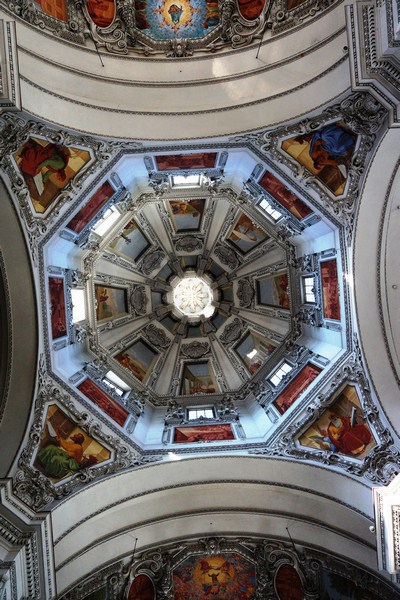
The cathedral dome with frescoes depicting scenes from the Old Testament around it. Above it are the coats-of-arms of Prince Archbishop Paris Lodron and Archbishop Andreas Roracher. At the corners are paintings of the Four Evangelists.
The figure group on the pediment, representing the Transfiguration of Jesus on Mt. Tabor, shows Christ as Salvator Mundi, with Moses holding the tablets on the left and the prophet Elijah to the right. Tommaso di Garona, the mason who built the Residenz Fountain, created the three statues in 1660. An old oven, used for baking communion bread, is housed in the north tower.
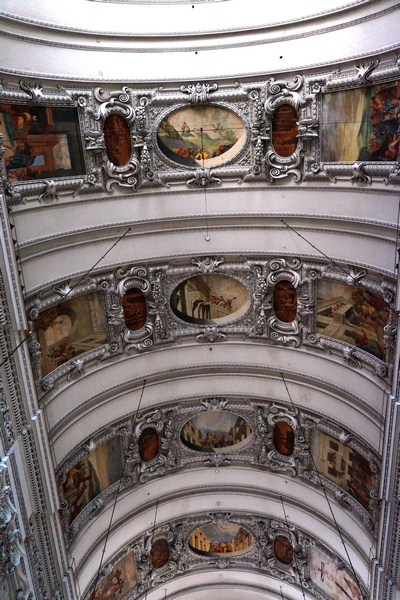
The main nave with paintings showing scenes from the life (10 smaller ones) and passion (15 large ones) of Christ, done by Donato Mascagni and Ignazio Solari.
The three bronze gates inside the portals, representing the 3 divine virtues (Göttliche Tugenden) of faith, hope and love, were erected in 1957 and 1958. The Gate of Faith (Tor des Glaubens ), on the left, was created by Toni Schneider-Manzell (1911-1996); the Gate of Love (Tor der Liebe), at the center, was created by Giacomo Manzù (1908-1991); and the Gate of Hope (Tor der Hoffnung), on the right, was created by Ewald Mataré (1887-1965). The flanking towers, also divided into three horizontal units, bear clocks and the bells.
Paintings on the main nave, showing scenes from the life (10 smaller ones) and passion (15 large ones) of Christ, were done by Donato Mascagni and Ignazio Solari. The stucco works were done in white (and crested by black stucco) by Guiseppe Bassarino around 1628. Four chapels, on each side along the main nave, each have a side altar and palatine frescos.
The 71 m. high dome, with two rows of eight frescos each, displays scenes from the Old Testament that relate to the life and passion scenes from the nave. They were also painted by by Donato Mascagni and Ignazio Solari.
On top of these paintings are paintings of the Four Evangelists (Mark, Luke, Matthew and John) and, beyond that, the coats-of-arms of Prince Archbishop Paris Lodron and Archbishop Andreas Roracher.
On the left and right side of the nave are motives of St. Francis and Virgin Mary respectively. To the left and right of the St. Francis Altar are epitaphs of Prince Archbishops Leopold Anton von Firmian (died in 1744), Guidobald von Thun (died in 1668), Max Gandolf von Kuenburg (died in 1687) and Jakob E. von Liechtenstein (died in 1747).
Around the Virgin Mary Altar are epitaphs of Prince Archbishops Andreas J. Dietrichstein (died in 1753), Johann E. Thun (died in 1709), Franz A. Harrach (died in 1727) and Siegismund Schrattenbach (died in 1772).
The main altar, probably built by Santio Solari in 1628, has a painting depicting the Resurrection of Christ and made by Donato Mascagni.
Above the painting are statues of St. Rupert and St. Virgil as well as allegories of Religio and Caritas. Between the figures is an inscriptions that reads: Notas mihi fecisi vias vitae (“You showed me the way of life”).
On top of the altar there are statues of angels holding golden crucifixes. The right and left hand side of the main altar has epitaphs of Prince Archbishops Markus Sittikus (died in 1619) and Paris Lodron (died in 1653) respectively.
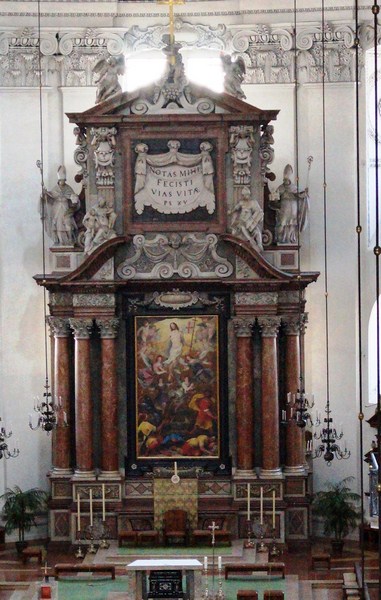
The main altar backdrop with a painting depicting the Resurrection of Christ made by Donato Mascagni
On the right hand side of the main altar is the entrance to the crypt (the tombs of the Archbishops of Salzburg) based on the foundations of the Romanesque Virgil Cathedral.
The Zehneckraum (“Ten corner room”) contains the tombs of the Prince Archbishops from the 17th to the 18th century. In the round tower is a mosaic showing the scale of the former Salzburger Dom in comparison to today′s cathedral.
The organ that is in use for services today was built in 1988. The old organ is essentially the same as the one built by the famous organ builder Josef Christoph Egedacher in 1703.
Salzburg Cathedral: Domplatz 1a, 5020 Salzburg, Austria. Tel: +43 662 80477950. Open 8AM-5PM. From June to September, there is a one-hour organ recital every Wednesday and Saturday at 11.15.

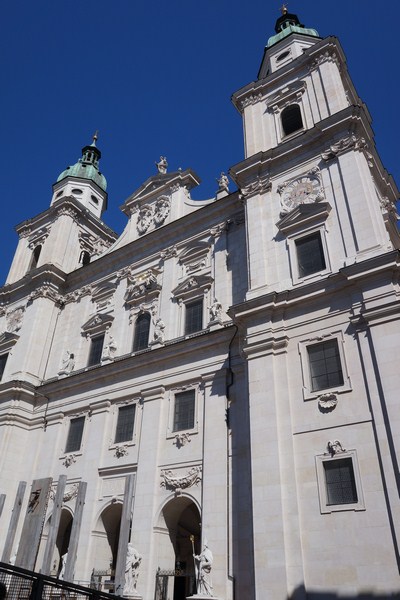

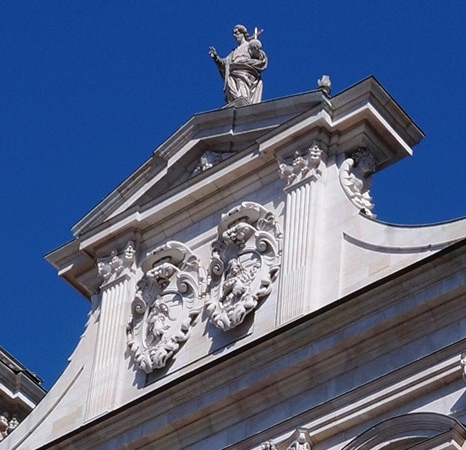
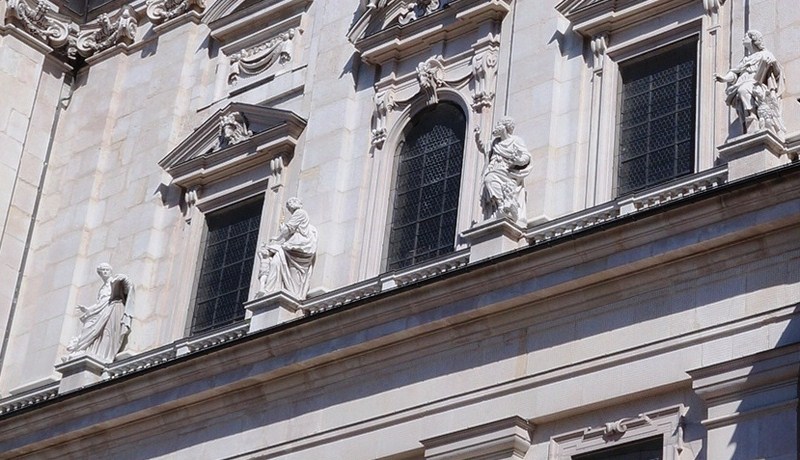
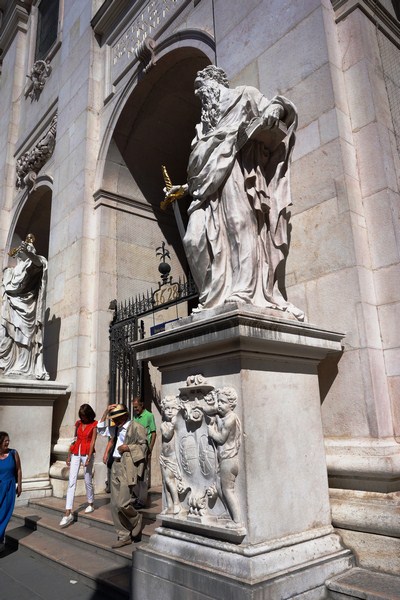
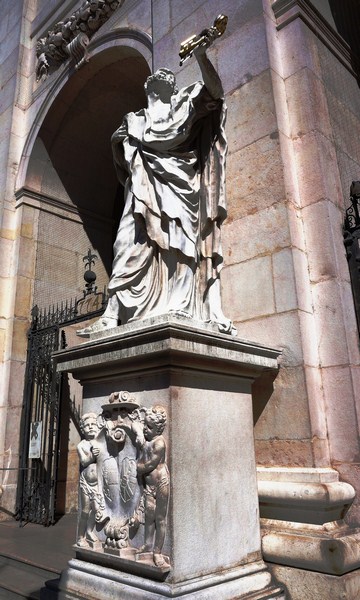

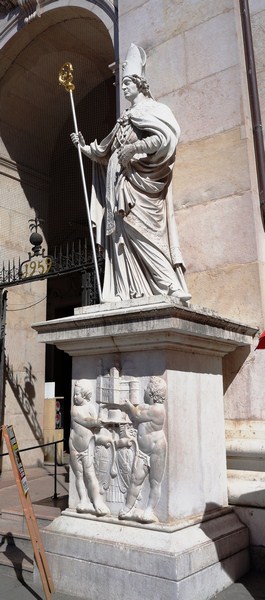
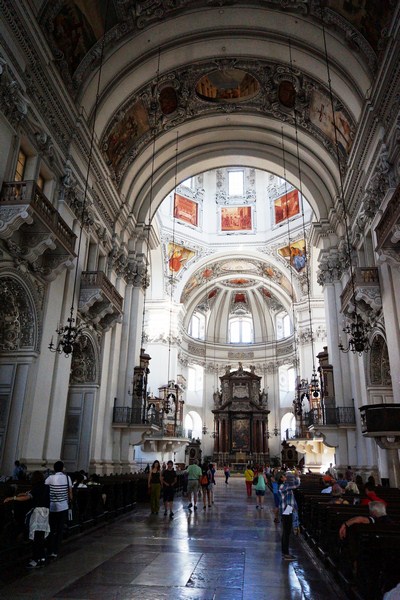
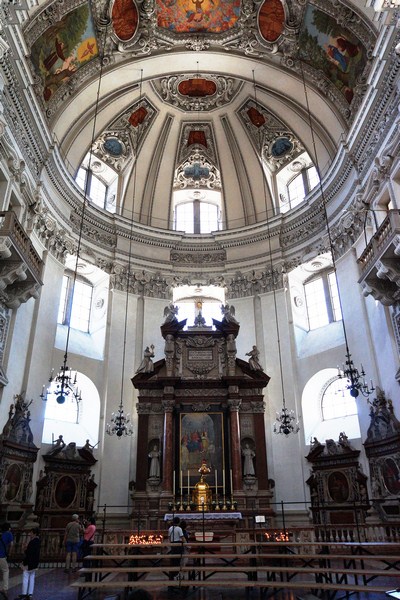



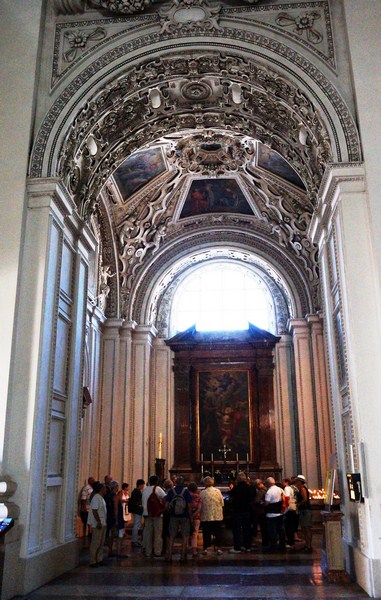


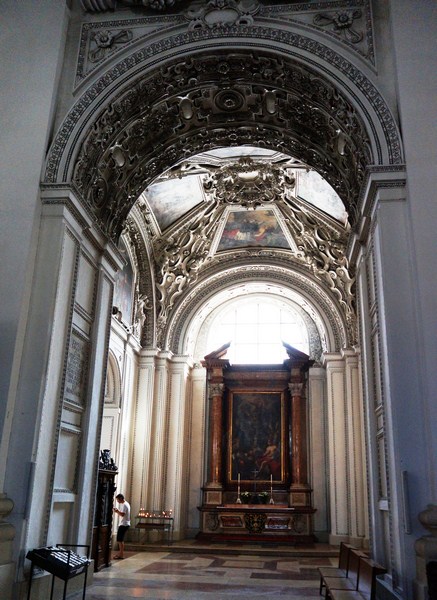


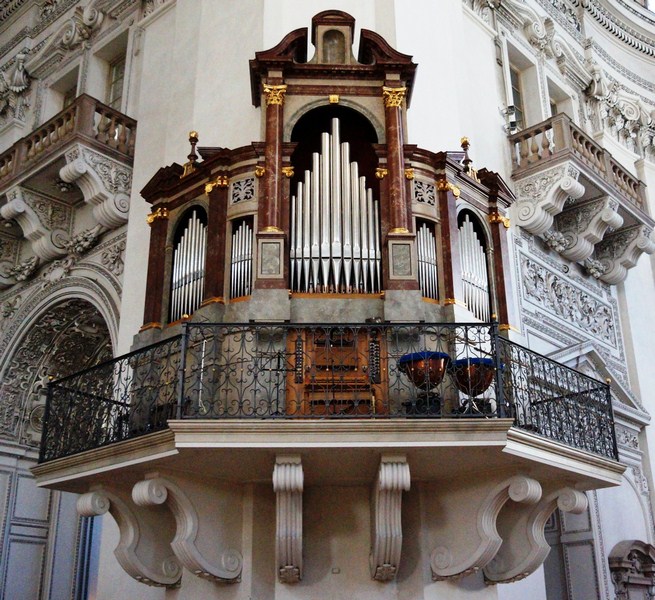
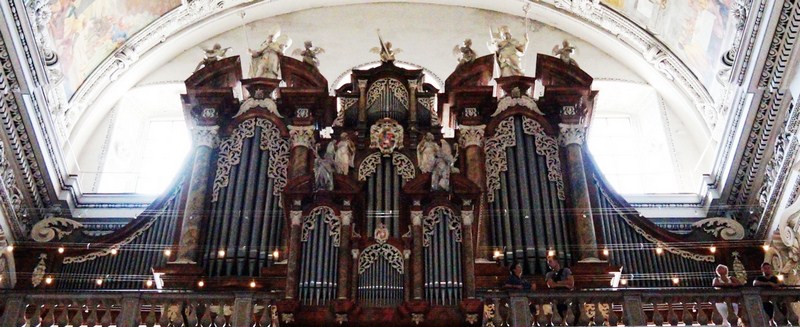
Pingback: Mozartplatz (Salzburg, Austria) – B.L.A.S.T. – Live Life to the Fullest ……… Don't Stay Put
Pingback: Kapitelplatz (Salzburg, Austria) – B.L.A.S.T. – Live Life to the Fullest ……… Don't Stay Put
Pingback: Residenzplatz (Salzburg, Austria) – B.L.A.S.T. – Live Life to the Fullest ……… Don't Stay Put
Pingback: Residenz Palace (Salzburg, Austria) – B.L.A.S.T. – Live Life to the Fullest ……… Don't Stay Put
Pingback: Residenzplatz (Salzburg, Austria) – B.L.A.S.T. – Live Life to the Fullest ……… Don't Stay Put